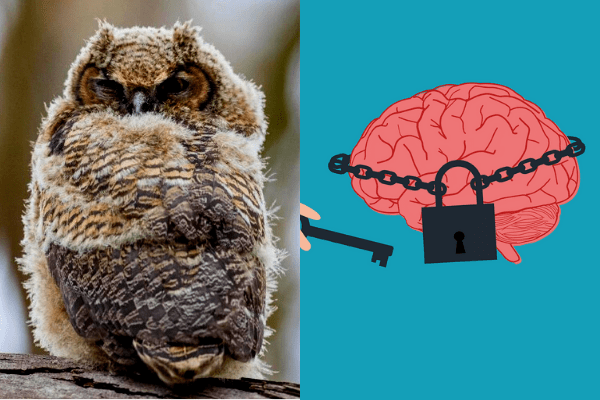Owls have long been associated with wisdom; with their frontward-oriented eyes, quiet movements, and calm, reflective faces, they give the impression of a profound intelligence. But what does science actually say about an owl’s intelligence?
Yet, studies of the modern era prove that owls are intelligent, just not in the way highly social problem-solving birds like crows or parrots would be. They exhibit a specialized form of intelligence based on their environmental pressures, hunting needs, and sensory capabilities.
Why Owls Have a Reputation for Wisdom
The owl has been a symbol of wisdom since the time of the ancient Greeks, wherein the Little Owl, or (Athene noctua), was the token of Athena, the goddess of wisdom. Their large eyes and upright posture give them a human-like, observant appearance reinforcing the idea of deep thought.
But science shows that appearance doesn’t equal intelligence. Owls aren’t “wise” in the human sense: they’re highly efficient predators with exceptionally developed sensory systems and specialized mental abilities.
The Owl Brain: Small but Extremely Efficient
An owl’s brain is small, yet highly optimized. What matters is not size but neuron density and how the brain’s networks are organized.
Key Points About the Structure of the Owl Brain
• A large part of their brain, particularly the pallium, is used for processing sound and vision.
• Owl brains are designed for rapid reaction, spatial precision, and split-second sensory integration.
• Their neural wiring supports stealth hunting, silent movement, and exceptional awareness.
This is a specialization that enables owls to succeed in low-light environments in which other birds cannot function.
Owl Intelligence Through Real Behaviors
Although owls are not known for solving puzzles or performing tricks, many species have surprisingly complex behaviors that show just how adaptable and clever they really are.
Examples of Owl Creativity and Strategy
• Little Owls cache pieces of meat until maggots appear and provide a renewable food source. This is an exceptional foraging behavior and unique among raptors.
• Burrowing Owls bring dung into their burrows to attract beetles, thus “farming” insects for easy food.
• Most Tawny Owls in rehabilitation seem to know when humans are trying to help them and adopt a calm, cooperative attitude.
• Barn Owls raised in captivity are non-aggressive and keenly observant but much more instinctive than problem-oriented.
These behaviors denote that the intelligence of owls is expressed through environmental management, flexibility in behavior, and situational awareness.
Sensory Intelligence: The Core of Owl Smartness
Owls are masters of the night, and much of their intelligence has to do with their sensory system.
Silent Flight
Specialized feathers featuring fringed edges and velvety surfaces allow flight with minimal noise.
Extraordinary Hearing
Asymmetrical ear openings help owls:
• Map sound in three dimensions
• locate prey under snow or vegetation
• hunt in complete darkness flawlessly
Night Vision
Owls collect whatever light is available far more efficiently than humans and detect motion with much greater precision.
Spatial Memory
They remember:
• Hunting routes
• Nesting areas
• Territorial boundaries
• Escape paths
These abilities represent sensory-driven intelligence, shaped for survival, not for solving problems in a style adapted to the laboratory.

Learning, Memory, and Behavior in Owls
Owls are capable of learning and remembering far more than most people think.
Learning Examples
• Barred Owls trained to associate a whistle with food learned the cue quickly.
• A familiar visitor known as “Houdini” did indeed remember the same whistle years later, showing long-term memory.
• Little Owls discriminate between familiar and strange humans, behaving differentially according to recognition.
These traits highlight their capacity for associative learning, memory retention, and behavioral adaptation.
Modern Neuroscience and Bird Intelligence
Recent research has transformed our understanding of avian intelligence.
Neuron Density Over Brain Size
Many species of birds have neurons that are packed very densely.
• Parrots and corvids have similar neuron counts as primates.
• More neurons in the pallium = more potential for advanced cognition.
Human-Like Neural Pathways
• Songbirds learn songs using circuits similar to human speech learning.
• Crows process faces using similar pathways to humans.
Evidence of Consciousness
A 2020 study about carrion crows showed neural patterns associated with conscious experience. Scientists point out that any bird with a developed pallium, including owls, possesses the groundwork for awareness.
This research shows that birds are far more cognitively sophisticated than previously believed.
Here’s a quick video that gives a brief look at owl behavior and intelligence.
Check out this moment from the Joe Rogan podcast where they dive into owl intelligence.
Sources and Credits
- What an Owl Knows by Jennifer Ackerman
- Ackerman, J. (2023). The New Science of the World’s Most Enigmatic Birds
- Personal stories and observations from Quora users
- Field research stories by ornithologist Rob Bierregaard
- Information from high-ranking educational and science sources on bird cognition and owl biology
- These links inspired some of the rewritten scientific and behavioral explanations:
- https://www.newscientist.com/lastword/mg24532641-300-twit-or-true-are-owls-really-intelligent/
- https://bioneers.org/what-an-owl-knows-rethinking-bird-brains-intelligence-ze0z2502/
Related Post
- What Does It Mean When You Dream About Owls : Explanation
- Do Owls Hibernate – Explanation
- What Does It Mean When You Hear An Owl
- Where Do Owls Go During The Day
Resources
- worldbirds.com
- escholarship.org

